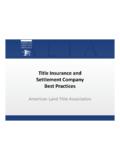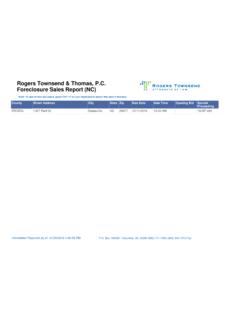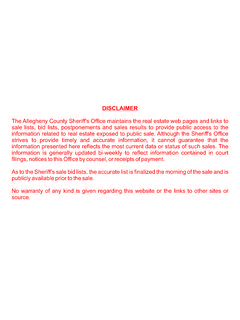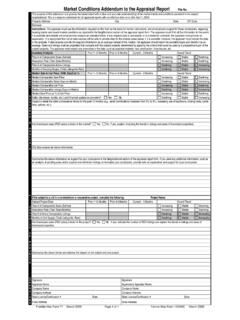Transcription of 11/5/2015 - Montana Land Title Association
1 11/5/2015 1 Montana Land Title Association 2015 Fall Education Seminar The Difference Between Mortgages and Trust Indentures in the foreclosure Process November 5, 2015 Kevin Heaney, Crowley Fleck, PLLP Familiarize you with the processes Explain Approaches and Rationale Won t become foreclosure experts, but familiarity will help with issue spotting Clarify misnomers Montana foreclosure law is different than those of other states Ask lots of questions 11/5/2015 2 Mortgages Trust Indentures- Pursuant to the Small Tract Financing Act, Mont. Code Ann. 71-1-301, et seq., a trust indenture may be used for property that does not exceed 40 acres in size. Contracts For Deed 11/5/2015 3 Trust indentures are typically foreclosed non-judicially pursuant to statute and do not allow for a deficiency if foreclosed non-judicially.
2 (Trustee s Sale). This process generally takes 150 -180 days. Mortgages are foreclosed judicially and allow for a deficiency to be entered against the borrower(s) or guarantor(s). The judicial foreclosure process to take approximately one year, with an additional 1 year redemption period. Non-judicial foreclosure is generally preferred over judicial foreclosure because: Less costly and time consuming (130-180 days) Borrower has no right of redemption No Lawsuit filed therefore no forum for the borrower to raise counterclaims or frivolous defenses to slow down the process * Note no deficiency upon completion of sale. 11/5/2015 4 PRELIMINARIES TO foreclosure Information Gathering Loan File Review Title Review. In the case of a mortgage foreclosure , this document is called a Litigation Guarantee, and in the case of the non-judicial foreclosure of a trust indenture, this document is called a Trustee s Sale Guarantee.
3 UCC Searches Notice of Default Many documents provide that no notice of overdue payments or of acceleration is necessary, but it is suggested that notice nonetheless be given ALTERNATIVES TO foreclosure Modification or extension of existing debt Work-Out Agreements Deed-in-Lieu of foreclosure Deed-in-Lieu of foreclosure ( Deed in Lieu ) Mortgaged property is deeded to the lender by the mortgagor or grantor, usually in exchange for a covenant not to sue the debtor for the debt. Advantages Avoids the time and expense of foreclosure . Allows for immediate resale of the property. No right of redemption Avoids greater loss to a lender where the property is worth the same or less than the debt and the debtor has few or no assets to pursue by deficiency judgment.
4 Avoids stigma of foreclosure and possible bankruptcy of the debtor. 11/5/2015 5 Potential Problems Property is taken by the creditor subject to junior liens. Conveyance might be set aside under the Bankruptcy Code as a fraudulent conveyance if the amount of the obligation from which the debtor is relieved is not reasonably equivalent to the value of the property conveyed. Non-Merger Warranty Deed to deal with the first two points Lender will keep mortgage of record until property is subsequently sold Covenant Not to Sue cancelling debt can create issues with underlying security interest If deed-in-lieu is combined with an option for the debtor to repurchase the property, the deed may be construed as an equitable mortgage.
5 Potential Problems (continued) Creditors Rights Endorsement No longer available Protected the lender against claims that the deed in lieu transaction represented a fraudulent or preferential transfer. Title insurers should still be aware these issues because basic Title insurance covers fraudulent and preferential transfers existing in the past chain of Title (from transfers before the present transaction being insured). Complex Legal Transaction Should include a settlement agreement, non-merger warranty deed, assignments, estoppels, etc. The Title insurance company will presumably want to review. Potential Problems (continued) Lenders should obtain a new Owner s Policy and not rely only on the continuation of the coverage under the existing Loan Policy Obtain a date-down for the Loan Policy (see below).
6 The Loan Policy does not insure the validity of the deed-in-lieu transaction or provide coverage for creditors rights issues in connection with the transfer of Title and it provides different claim coverage than a new Owner s Policy. The lender should, in addition to obtaining a new Owner s Policy in connection with a deed-in-lieu transaction, request endorsements to the existing Loan Policy: a non-merger endorsement and an endorsement insuring the continuing validity, enforceability and priority of the mortgage lien upon consummation of the deed-in-lieu transaction. 11/5/2015 6 3 Related but Different and Often Misunderstood Concepts: One-Action Rule: There is only one action for the recovery of debt or the enforcement of any right secured by a mortgage upon real estate.
7 In other words, the lender is prevented from waiving or ignoring the mortgaged property and suing directly on the note. Anti-Deficiency Statute: A deficiency judgment is not allowed when a trust indenture is foreclosed by advertisement and sale. See Mont. Code Ann. 71-1-317. This also bars recovery against any other person obligated on the note including a guarantor. First State Bank of Forsyth v. Chunkapura: A trust indenture may be judicially foreclosed as a mortgage. Mont. Code Ann. 71-1-304(3). The lender is entitled to a deficiency unless the trust indenture is on an occupied, single-family residence. PRIMARY THEMES Authority. Trust indentures are a creature of the Small Tract Financing Act and exist and are regulated pursuant to Mont.
8 Code Ann. 71-1-301, et seq. Purpose. Trust indentures were created for the purposes of promotion of the financing of homes and business expansion using security instruments and procedures not subject to all of the provisions of the mortgage laws. Size. Limited to tracts of 40 acres or less. Trustee. There must be a transfer in trust to a trustee: An attorney licensed to practice in Montana . A bank, trust company, or savings and loan authorized to do business in Montana . A Title insurance or Title insurance producer or agency authorized to do business in Montana . Beneficiary may appoint a successor trustee 11/5/2015 7 PRIMARY THEMES (Continued) Mortgage Treatment. Failure to meet all of the requirements of the statute will result in the trust indenture being deemed a mortgage.
9 No Deficiency. A deficiency judgment is not allowed when a trust indenture is foreclosed by advertisement and sale. Judicial Option. A trust indenture may be judicially foreclosed as a mortgage, but see Chunkapura in a single-family residential dwelling situation. Junior Liens. Junior liens are eliminated, but a junior lienholder whose lien created by a trust indenture is extinguished by the foreclosure of a first lien may maintain a direct action on the note (an exception to the one-action rule). The steps in a non-judicial foreclosure in Montana are as follows: Obtain a trustee sale guarantee: a Title guarantee issued at the start of foreclosure . It assists the foreclosing beneficiary and trustee with information such as owner of record, liens and encumbrances, parties required by law to be notified of foreclosure , etc.
10 Record the notice of sale (must be recorded at least 120 days prior to sale) and mail to interested parties; Publish the notice of sale in a paper of general circulation; Post a notice of sale on the premises; Obtain an updated trustee sale guarantee; Record affidavits of mailing, publication and posting; and Public sale by trustee SALE The sale is to be held pursuant to the notice. Some attorneys have the Title company record the notice of sale. Regardless, always obtain an endorsement to the Trustee s Sale Guarantee, changing the effective date to a time after the filing of the notice of sale. If there are any additional encumbrances or changes in Title , those parties will need to receive notice Sale must be for cash to the highest bidder.








